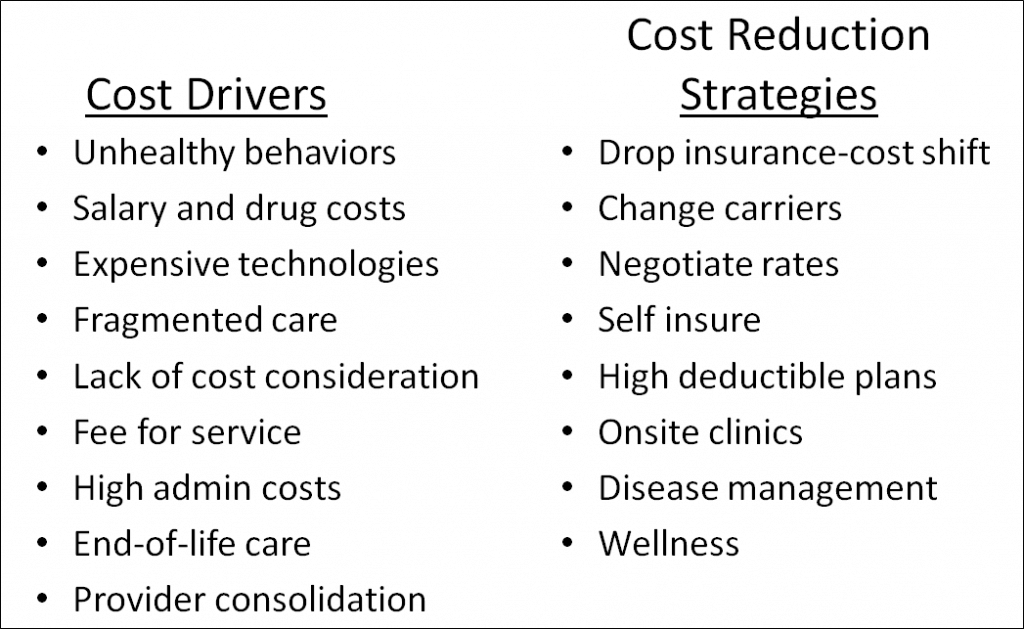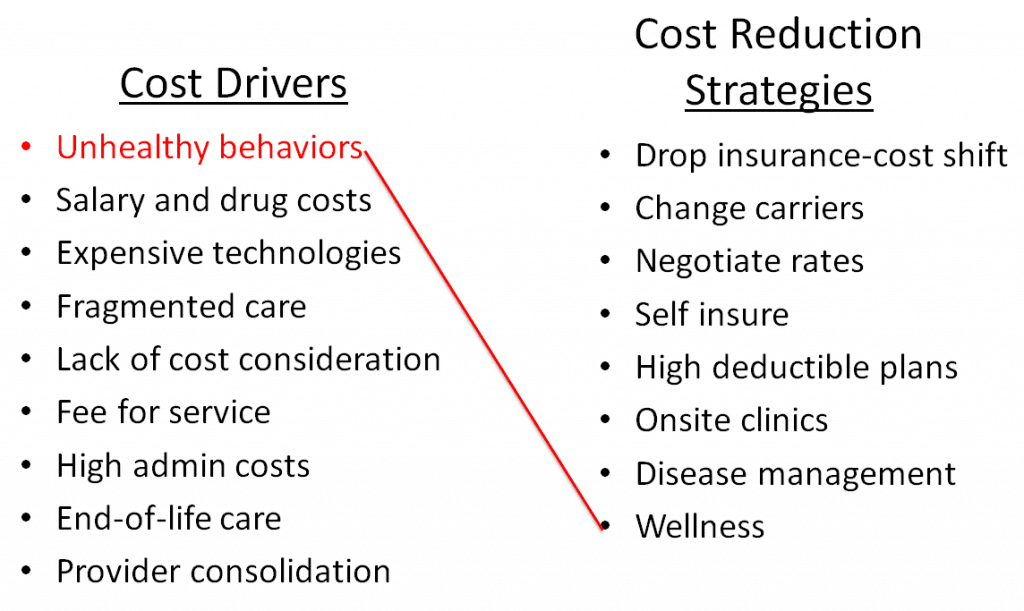The health and chronic disease prevention centers of America are now America’s worksites. There’s not a single group in America that does more to promote health and improve the health behaviors of our population than worksites. This presents a challenge for workplaces to implement effective and cost efficient health programs.
Our current medical system is a disease treatment system. The system is created it to treat, not prevent, arrest, or reverse health conditions. If you do have disease or existing health problems, the American system of medical care is very good, albeit extremely expensive.
The main reason worksites are in the workplace health business is to improve employee health and prevent employees from having to use our expensive medical system.
Employee wellness programs can impact employee health, but they have a limited direct impact on the high cost of health care because many drivers of high healthcare costs are not affected by wellness programs. We have good research that shows us what the main drivers of healthcare costs are.

Effective Workplace Health Programs Consider These Drivers of High Health Care Costs
Unhealthy Lifestyle Behaviors
Unhealthy lifestyle behaviors are responsible for most chronic diseases. These diseases cause approximately 70 percent of all deaths and up to 75% of all healthcare costs. Lack of physical activity, poor diets and tobacco use are directly responsible for 70-90% of chronic diseases.
Salary and Drug Costs
Salary and drug costs in the U.S. are the highest in the world. Physicians, nurses, and other healthcare providers make higher salaries than comparable professionals in other industrialized countries. In one company, the cost of medications has increased 27% in the past 12 months. Examples of soaring prices have been reported on multiple media outlets. Pharmaceuticals are the new gold rush.
Expensive Technology and Procedures
Expensive technologies and procedures such as MRI and CT scanning are medical marvels that come at a steep price. Fearing possible litigation, physicians will practice defensive medicine and order these scans when they are often unwarranted. Undoubtedly, this is one reason Americans do twice as much imaging as other populations in the industrialized world.
Fragmented Care
Fragmented care refers to the uncoordinated and disconnected care provided by many healthcare facilities. Multiple doctors from different facilities, incompatible records systems, multiple surgeries and duplicate lab tests are common features of our healthcare system. These factors contribute to the duplication of procedures and tests.
Cost Consideration
Lack of cost consideration really refers to a lack of cost transparency. Unlike free market transactions, where a buyer and a seller agree over a known price, most medical patients have no idea how much things cost. Consequently, by having insurance, many people never see the price of goods and services, and do not base their decision to purchase based on price. The healthcare provider and the insurance company decide the price, which makes it easier to increase prices.
Fee for Service
Fee for service means doctors only get paid when they provide a service—by putting something in or taking something out of you. Financial incentives are based on quantity of services provided, not quality. Hence, most physicians face direct financial pressure to provide a service, whether or not it is needed.
Administrative Costs
High administrative costs exceed $1,100 per person per year. Excluding the actual cost of providing health care, it costs $1,100 per person just to administer health care in the U.S.
End-of-life Care
End-of-life care is the most expensive of all medical care. One out of every four Medicare dollars is spent on end-of-life care. In 2012, that was $125 billion.
Provider Consolidation
Provider consolidation means hospitals and physician groups are banding together with the goal of increasing market share. With each consolidation comes the tendency to increase the cost of services because of reduced competition.

This list of cost drivers is not comprehensive but it does include the most important ones. Worksites may not see or understand how healthcare costs are impacted by these drivers, but they do recognize strategies that can help slow cost increases. Some of these are more effective than others, depending on the worksite.
Strategies to Reduce Health Care Costs
Drop Insurance
Drop insurance completely by forcing employees to seek healthcare coverage in the exchanges. Larger employers can pay the federal penalty each year and pass the remaining cost of health care directly to the employee. Many companies have considered this as another version of healthcare cost shifting. In fact, this is exactly what Walmart did with it’s 30,000 part-time employees. Others are doing the same. If dropping insurance coverage is too bold, you can do what most employers do, pass the cost increase along to your employees.
Change Carriers/Negotiate Rates
Change insurance carriers/ negotiate better rates in an attempt to get better pricing. Most carriers will negotiate hard to get your business. It may be possible to shave a few percentage points off the cost during year one, but soon after the honeymoon is over, cost increases continue. This strategy is usually a dead end.
Self-Insure
Self-insuring means employers pay for employee healthcare costs directly. With this approach the risk of high healthcare costs is born by the employer. Stop loss policies help protect agains catastrophic costs. Once thought to be a strategy of large corporations, there are insurance companies that will self-insure a company with as few as 50 people. This can help reduce approximately 7% of the costs associated with administering a fully insured insurance plan.
High Deductible Plans
High deductible plans are more popular than ever. They are the ultimate in cost-shifting. Some studies have shown that when your employees begin a high deductible healthcare plan, healthcare costs can be reduced by as much as 5-14%.
On-site Clinics
On-site clinics are loved by employees and they may well have a big impact on employee productivity, but it is still unclear if they can actually reduce healthcare costs.
Disease Management Strategies
Disease management includes strategies to manage the chronic conditions of high-risk, high-cost employees. The research says disease management can improve patient care and may improve health outcomes, but fails to save money.
Employee Health Programs
Workplace health programs are one of the most effective and well-accepted cost reduction strategies. Many employers have demonstrated that effective workplace health programs don’t eliminate the drivers of healthcare costs, but they do reduce the demand for healthcare services. Said another way, workplace health programs help worksites avoid high health care costs because they help employees stay healthy and stay out of the healthcare system.

Worksite wellness programs will not impact all the drives of healthcare costs, but they can impact unhealthy behaviors and this is how wellness programs save money.
By helping employees adopt and maintain healthy behaviors, they improve their health and avoid chronic diseases. Without chronic disease, we greatly reduce the cost of health care.
So What Next to Implement Effective Workplace Health Programs?
In short, this last image shows how an effective employee wellness program can have a direct impact on at least one of the divers of healthcare costs: unhealthy behaviors.
Good wellness programs keep people out of the healthcare system. Because, when you are outside the healthcare system, the drivers of healthcare costs are less impactful. Reduced health care costs is just one way wellness programs save money.
FAQs About Effective Workplace Health Programs
What exactly is a wellness program?
Basically, an employee wellness program consists of health promotion strategies designed to aid employees in their health and prevent chronic disease. Employers can provide workplace wellness programs in house or through a vendor. To learn about what programs WellSteps has to offer, click here. If you are planning on creating an internal program, this blog post has a variety of health-promoting ideas to help you get started.
What are some ways to improve workplace health?
At WellSteps, we believe in making small, sustainable changes. We often see ads for a short term challenge that has extreme restrictions on diet or requires an unusual amount of exercise. Most people would not be able to keep up these behaviors for the rest of their lives. Through the WellSteps program, participants learn how to make small changes that lead to life-changing results. Employers can support these efforts by making the healthy option the easy option. For example, they can provide fresh produce in their cafeteria rather than processed foods. Employers can also encourage walking meetings and mental health breaks. For more ideas on how to integrate health and wellness into the workplace, see this article.
What makes a successful wellness program?
To create an effective workplace health program, you will need senior leader support and an engaged program coordinator/wellness committee. This means that the senior leader and wellness committee are actively participating in the program and helping make decisions. The best wellness programs involve healthy activities backed by research and include all aspects of wellness, not just exercise and nutrition. Another essential element for success is valuable incentives that reward participation. To learn more about wellness incentives, click here.
[maxbutton id=”1″]
